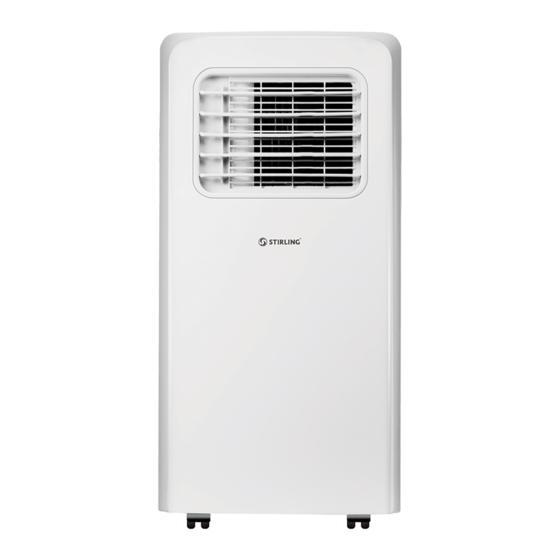Summary of Contents for Stirling PA19W Black Edition
- Page 1 Wi-Fi Portable Air Conditioner (1.9kW Cooling) Model Number PA19W SERVICE MANUAL AFTER SALES SUPPORT info@tempo.org 1300 886 649 MODEL: PA19W PRODUCT CODE: 703227 11/2020...
- Page 2 R290-Specific Safety Advice Important safety precautions concerning refrigerant R290 WARNING: Combustible & Dangerous This symbol alerts you to take care as the appliance contains a flammable refrigerant: R290 (propane). Take extra care when installing the unit and when carrying out maintenance. R290 is a colourless and odourless hydrocarbon gas.
- Page 3 Service Instructions • Special training additional to usual refrigerating equipment repair procedures is required. For maintenance, service and repair operations, the working personnel needs to be certified. • Examples for such working procedures are: – breaking into the refrigerating circuit –...
- Page 4 Service Instructions (Cont.) 1. Checks to the area Prior to beginning work on systems containing flammable refrigerants, safety checks are necessary to ensure that the risk of ignition is minimised. For repair to the refrigerating system, points 1.2 to 1.6 below shall be completed prior to conducting work on the system.
- Page 5 Service Instructions (Cont.) 1.6 Ventilated area Ensure that the area is in the open or that it is adequately ventilated before breaking into the system or conducting any hot work. A degree of ventilation shall continue during the period that the work is carried out. The ventilation should safely disperse any released refrigerant and preferably expel it externally into the atmosphere.
- Page 6 Service Instructions (Cont.) Repairs to sealed components 4.1 During repairs to sealed components, all electrical supplies shall be disconnected from the equipment being worked upon prior to any removal of sealed covers, etc. If it is absolutely necessary to have an electrical supply to equipment during servicing, then a permanently operating form of leak detection shall be located at the most critical point to warn of a potentially hazardous situation.
-
Page 7: Leak Detection Methods
Service Instructions (Cont.) 8. Leak detection methods The following leak detection methods are deemed acceptable for all refrigerant systems. 8.1 Electronic leak detectors may be used to detect refrigerant leaks but, in the case of flammable refrigerants, the sensitivity may not be adequate, or may need re-calibration. - Page 8 Service Instructions (Cont.) 9.4 Ensure that the outlet for the vacuum pump is not close to any ignition sources and that ventilation is available. 10 Charging procedures In addition to conventional charging procedures, the following requirements shall be followed. 10.1 Ensure that contamination of different refrigerants does not occur when using charging equipment.
- Page 9 Service Instructions (Cont.) 11.7 Start the recovery machine and operate in accordance with manufacturer’s instructions. 11.8 Do not overfill cylinders. (No more than 80% volume liquid charge.) 11.9 Do not exceed the maximum working pressure of the cylinder, even temporarily. 11.10 When the cylinders have been filled correctly and the process completed, make sure that the cylinders and the equipment are removed from site promptly and all isolation valves on the equipment are closed off.
- Page 10 Service Instructions (Cont.) 13.5 If compressors or compressor oils are to be removed, ensure that they have been evacuated to an acceptable level to make certain that flammable refrigerant does not remain within the lubricant. The evacuation process shall be carried out prior to returning the compressor to the suppliers. Only electric heating to the compressor body shall be employed to accelerate this process.
- Page 11 Service Instructions (Cont.) – Evacuate the refrigerant circuit. – Purge the refrigerant circuit with nitrogen for 5 min. – Evacuate again. – Remove parts to be replaced by cutting, not by flame. – Purge the braze point with nitrogen during the brazing procedure. –...
- Page 12 Technical specifications Compliance Model PA19W This appliance has Cooling capacity 1.9kW been fully tested and Refrigerant, quantity R290, 140g meets all requirements as set out by Discharge 2.6MPa Permissible excessive standards AS/NZS operating pressure Suction 1.0MPa 60335.1 and AS/NZS Discharge 3.2MPa 60335.2.40.
















Need help?
Do you have a question about the PA19W Black Edition and is the answer not in the manual?
Questions and answers